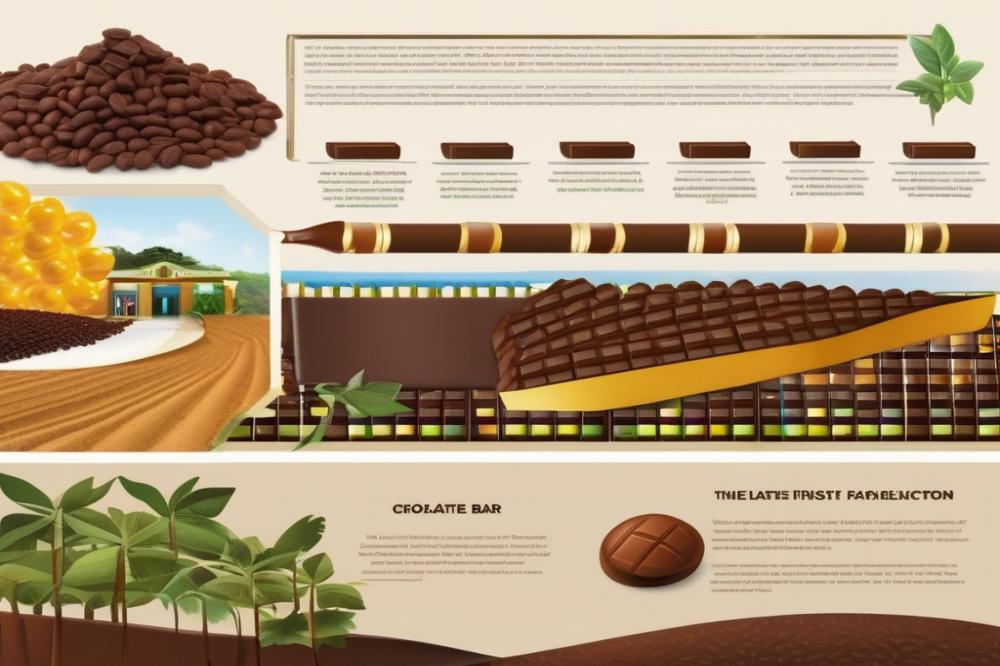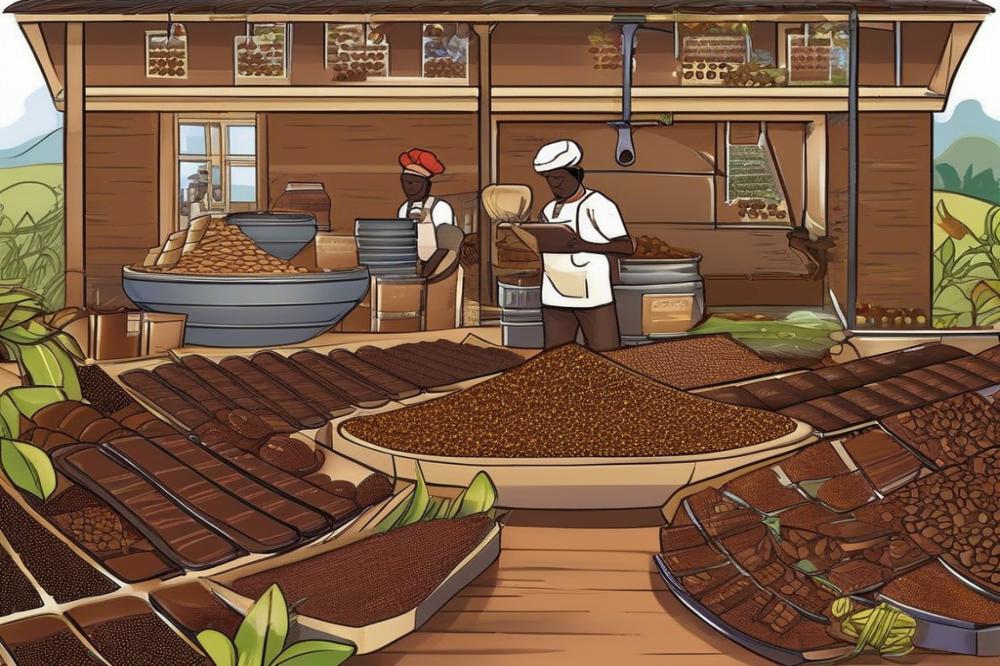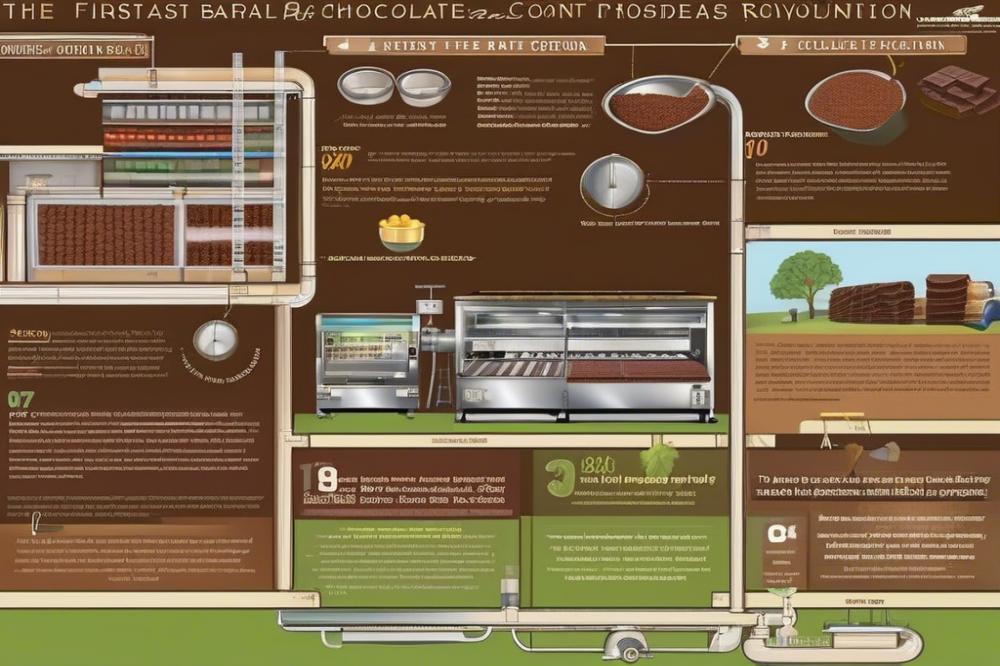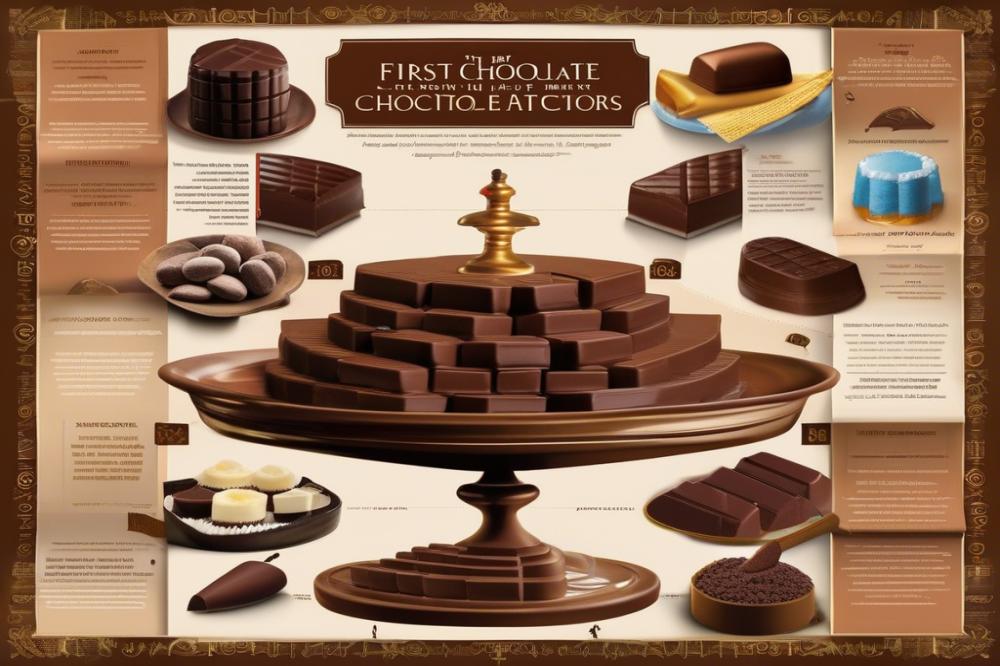Introduction
The journey of chocolate from bean to bar is an enthralling saga. It all begins in the lush cocoa plantations where beans are harvested. Farmers carefully pick ripe cocoa pods, initiating a process steeped in tradition. Once harvested, beans undergo fermentation and drying, essential steps for developing their flavor. After this, they are shipped globally for processing. The story shifts dramatically with the rise of industrialization.
In the 19th century, early chocolate factories emerged, forever changing chocolate production. They introduced new manufacturing techniques that enhanced efficiency. Automation played a critical role in this shift, allowing for large quantities to be produced quickly. With innovations like tempering machines and conching processes, chocolate became a more consistent product. Quality control became vital during this period, ensuring that every piece met high standards.
These chocolate factories didn’t just revolutionize the way chocolate was made; they changed the entire supply chain. Mass production made chocolate available to many more people than ever before. At the same time, the growth of industries encouraged market expansion. Artisanal chocolate still holds a special place in the hearts of many, but industrial methods paved the way for new flavors and styles.
With the changing times, sustainable practices have become crucial. Today, responsible sourcing of cocoa is more vital than ever. The push for quality and ethical standards reflects the evolving demands of consumers. This production revolution shows no signs of slowing, as the world continues to embrace chocolate in its various forms. The future is bright for chocolate lovers, thanks to the innovations sparked by early manufacturers.
The Birth of Chocolate Factories

Chocolate has a long and rich history, yet the way it is made has changed drastically over time. Initially, cocoa processing was a craft. Artisans skillfully roasted beans, crushed them, and mixed them by hand. Each batch had its own special touch, but this method was slow and limited. The world was on the brink of industrialization, and the production of chocolate was about to be transformed.
Origin of Chocolate Processing Techniques
Creating chocolate started as an artisan process that focused on small-scale production. Methods involved grinding cocoa beans using stones. This was labor-intensive and time-consuming. As demand for chocolate increased, it became clear that these techniques needed an upgrade. The search for better approaches was on.
The Transition from Artisanal to Industrial chocolate production
With the rise of factories, chocolate production began to shift dramatically. Machines took over many tasks once handled by skilled hands. This change allowed for faster output. Automation played a key role in this revolution. Mass production could finally meet the public’s growing appetite for chocolate. Soon, chocolate bars became widely available instead of being a luxury item just for the few.
Key Innovations in Manufacturing Techniques of the First Factories
Innovations in these factories changed everything. New manufacturing techniques emerged, making it easier to produce chocolate consistently. Continuous mixing and conching improved texture and flavor. Quality control became crucial at this level. With a focus on sustainability, factories sought to adapt their supply chains. Reducing waste while maintaining high standards was not just a goal, but a necessity.
The introduction of temperature-controlled environments helped refine the chocolate-making process. Uniformity became easier to achieve, while still allowing for some unique qualities that consumers appreciated in artisanal chocolate. Factories also began exploring different cocoa varieties, pushing the boundaries of taste and experience in each bite.
In essence, the birth of these factories marked a turning point. They balanced efficiency with quality. Consumers enjoyed the benefits of lower prices and greater availability. As a result, chocolate became a beloved treat for everyone, not just the elite. This journey laid the groundwork for the deliciously rich world of chocolate we know today.
Industrialization and Its Impact on Chocolate Production

The era of industrialization dramatically changed chocolate production forever. Factories began to replace small workshops, allowing for larger-scale operations. This shift not only increased the amount of chocolate available but also made it more affordable for everyday consumers. With innovation at the forefront, manufacturing techniques evolved quickly. Machines took over many tasks that were once done by hand, paving the way for automation.
Cocoa processing experienced a significant makeover during this time. Old methods became outdated as factories embraced advanced equipment. These innovations sped up the grinding of cocoa beans and the mixing of ingredients. As processes became more efficient, quality control received more attention. Factories could now produce consistent results while using less labor. This balance helped maintain the quality that chocolate lovers desired.
Automation played a key role in enhancing production efficiency. Machines could operate nonstop, which meant higher output than ever before. This newfound capability opened doors for competition among various brands. Chocolate became a staple in households. With increased availability, everyone began to enjoy it, regardless of income level. Artisanal chocolate still had its charm, but mass production filled the shelves.
The effects on the supply chain were undeniable. As more cocoa beans were sourced, the price dropped due to increased availability. Sustainable practices became necessary as demand surged. Factories sought to balance profit with ethics by ensuring they sourced cocoa responsibly. The rise of commercial chocolate transformed the market landscape, offering options for all tastes.
Overall, industrialization ushered in a new era for chocolate. Production methods evolved, paving the way for automation and consistency. The average consumer gained better access to chocolate, which made it a beloved treat across various demographics. This transformation marked the beginning of a sweet revolution.
Quality Control and Innovation in Chocolate Factories

Quality control measures were essential to the early chocolate production processes. As factories emerged, they needed to ensure consistency in taste and texture. This was a significant shift from traditional methods where each batch of chocolate could vary greatly.
Innovative approaches played a vital role in maintaining chocolate quality during mass production. Automation became a game changer in cocoa processing, allowing for precise control over recipes. With machines handling many tasks, human error decreased, and product reliability increased.
Comparison of traditional methods with the new factory processes reveals interesting differences. Artisanal chocolate makers relied on small-scale production techniques. They often used minimal equipment and focused on handcrafted quality. In contrast, factory production emphasized speed and efficiency. Manufacturing techniques evolved to streamline operations, which was crucial as demand grew.
Some chocolate manufacturers adopted sustainable practices to address environmental concerns during industrialization. These methods not only helped the planet but also appealed to consumers who value ethical sourcing. Responsible sourcing of cocoa influences the overall flavor and quality of the product.
Advanced quality control systems now monitor every aspect of production. Factors such as temperature, humidity, and ingredient quality are tracked in real time. These innovations help create a homogenous product that satisfies consumer expectations consistently.
While traditional chocolatiers create unique, small-batch items, factories produce chocolate on a grand scale. This raised questions about the authenticity of flavor and texture. However, many modern innovations bridge this gap, allowing for high-quality chocolate experiences.
Factories don’t only focus on quantity; they also aim to revolutionize the supply chain. Improved logistics ensure fresh ingredients reach production lines faster. As a result, chocolate lovers can enjoy fresher products more often.
Sustainable Practices in Early Chocolate Factories

Awareness of cocoa sourcing and its impact on the environment began to grow as chocolate gained popularity. Consumers started paying attention to where their favorite treat came from. This awareness prompted early chocolate manufacturers to think differently about their sourcing methods.
Early efforts towards sustainable practices in chocolate manufacturing were not just a trend; they were necessary for the future. Some factories began adopting methods to reduce waste. They explored organic cocoa options and prioritized relationships with local farmers. This shift positively impacted the quality of the beans and the local communities that cultivated them.
Furthermore, the influence of sustainable practices spread as more factories adopted eco-friendly methods. Automation played a key role in enhancing efficiency while still respecting the environment. Innovations like responsible sourcing and better quality control emerged to support these practices. By focusing on sustainability, these factories paved the way for modern chocolate production that still values craftsmanship.
Artisanal chocolate makers also took cues from early industrialization efforts. They embraced similar ideals, emphasizing sustainable cocoa processing while maintaining quality. By combining traditional techniques with new manufacturing techniques, they created chocolate with a lower environmental footprint.
Today, we see a significant shift in the entire supply chain as many chocolate brands commit to greener practices. Consumers, more informed than ever, demand transparency about cocoa production. This ongoing dialogue reinforces the importance of sustainability in the chocolate industry.
The Evolution of the Chocolate Supply Chain
The journey from cocoa bean to chocolate bar is not as simple as it seems. Over the years, the supply chain for cocoa and other chocolate ingredients has undergone significant changes. These changes have transformed chocolate production and made it more efficient.
Initially, farmers harvested cocoa beans by hand. Their methods were traditional and often labor-intensive. As the demand for chocolate grew, factories began to emerge. Early cocoa processing factories needed a steady supply of raw ingredients. This relationship boosted the livelihoods of many cocoa growers. Farmers found new markets for their beans. They benefited from stable prices and increased demand.
As industrialization took hold, manufacturing techniques evolved rapidly. Automation played a crucial role in the chocolate-making process. Factories integrated machinery to grind, mix, and mold chocolate. These innovations allowed for quick production rates, reducing costs. However, not all changes were welcomed. Artisanal chocolate producers sought to maintain quality over speed. They focused on unique flavors and sustainable practices instead of mass production.
Today, the cocoa supply chain reflects both complexity and connection. Quality control has become essential in ensuring that chocolate meets consumer standards. Modern factories must balance efficiency with ethical sourcing. Sustainable practices help protect the environment and support farmers. This approach has become increasingly important in a world that values corporate responsibility.
The economic impacts of these developments are profound. Producing chocolate on a large scale has generated millions of jobs worldwide. This success has led to investment in infrastructure in cocoa-growing regions. Increased income from cocoa sales has improved lives. However, challenges still exist, such as fair trade practices and worker rights.
Innovation remains central to the chocolate supply chain. New products and flavors emerge regularly, catering to diverse consumer tastes. As interest in health grows, dark chocolate and alternatives gain popularity. Digital tools and online markets also provide opportunities for smaller producers. They can reach consumers directly without relying solely on traditional retail channels.
The Rise of Artisanal Chocolate in Response to Factories
As chocolate production ramped up during the industrial era, many began to crave a different experience. The rise of factories brought mass-produced treats, but not everyone was satisfied. Some enthusiasts wanted more than just chocolate bars wrapped in shiny paper. What they sought was depth, flavor, and the personal touch that comes from craftsmanship. Thus, the artisanal chocolate movement emerged.
Artisanal chocolate responds to the repetitive processes of large-scale manufacturing. Chocolatiers focus on small batches, allowing for creativity and quality. Unlike the standard uniformity produced by big companies, craft chocolate boasts diverse flavors and textures. Each piece can tell a story, showcasing unique ingredients and local cocoa processing methods. This makes every bite a delightful adventure.
Balancing mass production with craftsmanship is not an easy task. On one hand, many companies use automation to streamline their operations. This leads to efficiency and lower costs. On the other hand, there is an undeniable charm in handcrafted treats. Innovative techniques in the artisanal scene ensure that chocolate lovers can still enjoy high-quality products without compromising on taste.
Quality control remains essential in both realms of chocolate making. While factories might focus on meeting demand, small producers emphasize ingredient integrity. Sustainable practices like sourcing cocoa through fair trade are often a priority for artisans. These values resonate with consumers who want to connect with the origin of their chocolate.
In a world dominated by factory-produced confections, artisanal chocolate stands out. It offers an inviting reminder of what chocolate can be. The passion and dedication of craft chocolatiers are evident in their work. As the supply chain becomes more complex, these small producers continue to thrive. They adapt while staying true to their principles. For many, supporting artisanal chocolate means investing in quality over quantity, experience over efficiency.
Artisanal chocolate is not just about indulgence. It is a movement that champions creativity and authenticity. Chocolatiers develop ongoing relationships with cocoa farmers, ensuring sustainable practices throughout production. The ongoing relevance of these practices highlights a desire for connection in a factory-oriented world. Consumers now look for chocolate that reflects their values, making every purchase meaningful.
Wrapping Up the Chocolate Journey
The emergence of the first chocolate factories marked a pivotal transition in chocolate production. Industrialization transformed how this beloved treat was made and distributed. Instead of small batches crafted by hand, large-scale operations began to dominate. These factories revolutionized the process, making chocolate widely accessible and significantly increasing output.
Long-term effects on consumer experiences were profound. Chocolate became a common treat and an integral part of many cultures. People enjoy it in various forms, from bars to drinks. The affordability and variety made it a staple in households worldwide. With this shift, chocolate evolved from a luxury good to an everyday pleasure.
Looking ahead, the future of chocolate manufacturing continues to evolve. Sustainable practices are gaining traction, focusing on ethical sourcing and environmental responsibility. Companies are exploring ways to reduce waste and promote fair trade. As consumers become more conscious, businesses will need to adapt to these preferences to survive.
As we conclude this exploration of chocolate factories, it’s clear that their impact on the chocolate world is vast. They not only changed production but also shaped our relationship with this sweet delight. With ongoing innovation and a commitment to sustainability, the future looks bright for both chocolate lovers and manufacturers alike.



